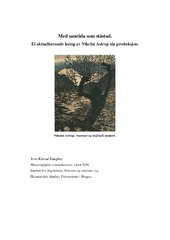| dc.description.abstract | Med utgangspunkt i biografien, tek kunsthistoria sine kontekstualiseringar av Nikolai Astrup (1880-1928) sine bilete oftast sikte på å forklare kunstverka i vekslinga av brot og kontinuitet i høve dei fortidige og samtidige kunstnariske utslag, og kunstverka vert slik eit punkt på den kunsthistoriske aksen. Som betraktarar har vi også ei forforståing gjennom velbrukte omgrep som romantikk og heimstadkunst, og blikket vert oppfordra til å observere fjord, fjell og vestlandsnatur. I møte med kunstartar frå samtidskunsten sin arena og teoriar som har sprunge ut av desse, har eg vorte motivert og inspirert til formuleringa av problemfeltet i denne avhandlinga: ei aktualiserande lesing av Astrup sine verk. Samtidskunst og samtidsbilete taler til oss i vår eiga tid og med vårt eige språk. Astrup sine verk heng riktig nok føre oss i dag, men den historiske avstanden til bileta kan gjere desse vanskeleg å gripe. Med samtida som ståstad har eg ein tanke om at samtida og samtidskunsten sitt vokabular og tendensar kan stimulere til nye forståingshorisontar og perspektiv, og eg vil derfor sjå forbi kunsthistoria si analoge lesing av kunstverk og teori i denne aktualiseringa. Med støtte i aktuell filosofi og kunstteori vil det nye perspektivet vere representert gjennom tematisering av staden, og temaet vil også vere berande for oppgåva sin struktur. | en_US |
| dc.description.abstract | This paper is based on the idea that new perspectives and forms of expression in contemporary art and philosophy can open up for alternative readings of older art historical works. Traditionally, art history is read as a story of continuity or as ruptures of this continuity, where theory and art works follow each other in a chronological order. The context of the works is explained through the artists' life and education, and in relation to social, political or economical factors. This is also the case in the readings of the Norwegian painter Nikolai Astrup (1880-1928): his paintings are traditionally read as neo-romantic or national-romantic landscape paintings, and the explanation follows the biographical preferences where the paintings work as illustrations of this artist life. These contexts are interesting and valuable, but the readings also tend to end in this "biographical room". This thesis discusses the problem of bringing Astrup´s works up to date. Astrup found his inspiration and motives almost exclusively at his home place - Jølster - and I have chosen to analyse a selection of works which clearly are produced as sequences or repetition of the same motives. He is not the first or only artist who works in this way. The same tendency can be seen in impressionists and neo-impressionists works such as Monet and Cezanne - but also in minimalistic works, for example in Judd´s specific objects. Astrup´s paintings are however not minimalistic in colour and they are also independent works. But the comparison may open up for new ways of thinking across the boundaries of time. Seen in relationships to each other the works character of being site-specific will become even more visible. Through the concepts of specific site and site-specific art I have tried to read the site in Astrup´s sequential work from another point of view than the national romantic aesthetics. Approaching the site with reference to Anniken Greve´s contribution to the philosophy of site, Her (1998), I have discussed the particular way Astrup articulates his motives. Thus I have accentuated his eye for the place. He does not only approach the landscape as an entity or a whole, but he also presents the landscape as a kind of caricature. Some parts are enlarged, others have been removed, something that tells us that the characteristics of the place are important - the site is specific. Astrup arranges his motives in a concrete, physical sense. An example of this is Seljekallen (see fig. 23, 24, 52 and 53) - a representation of a tree, which could be read as landart in the site-specific literal sense. In the process of making this motif, he also made use of photography - and by reading his notebooks we find that the purpose of this was to capture the changing conditions in nature, like weather, lights etc. The notebooks also reveal a curious interest in details. Astrup`s photographic practice has barely been discussed by earlier scholars, and this opens up for a new and interesting understanding of Astrup´s way of seeing and of the paintings themselves. Finally, I have also looked at the changing role of the spectator - from then to now. In contemporary art, the viewer is more and more challenged to interact with the exhibited works, and I have discussed whether this kind of interaction also has a potential for the approach to Astrup´s painting. Doing so, we are once again drawn to the specific site: Jølster. At the particular site, the senses will be activated in a way that will let us experience the paintings through more dimensions than the eyesight alone. | en_US |
